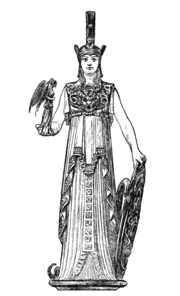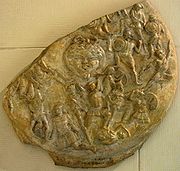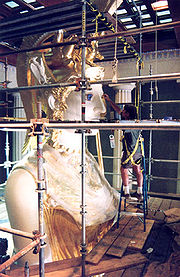
Athena Parthenos
Encyclopedia

Chryselephantine
Chryselephantine is a term that refers to the sculptural medium of gold and ivory...
sculpture
Sculpture
Sculpture is three-dimensional artwork created by shaping or combining hard materials—typically stone such as marble—or metal, glass, or wood. Softer materials can also be used, such as clay, textiles, plastics, polymers and softer metals...
of the Greek goddess
Greek mythology
Greek mythology is the body of myths and legends belonging to the ancient Greeks, concerning their gods and heroes, the nature of the world, and the origins and significance of their own cult and ritual practices. They were a part of religion in ancient Greece...
Athena
Athena
In Greek mythology, Athena, Athenê, or Athene , also referred to as Pallas Athena/Athene , is the goddess of wisdom, courage, inspiration, civilization, warfare, strength, strategy, the arts, crafts, justice, and skill. Minerva, Athena's Roman incarnation, embodies similar attributes. Athena is...
made by Phidias
Phidias
Phidias or the great Pheidias , was a Greek sculptor, painter and architect, who lived in the 5th century BC, and is commonly regarded as one of the greatest of all sculptors of Classical Greece: Phidias' Statue of Zeus at Olympia was one of the Seven Wonders of the Ancient World...
and housed in the Parthenon
Parthenon
The Parthenon is a temple on the Athenian Acropolis, Greece, dedicated to the Greek goddess Athena, whom the people of Athens considered their virgin patron. Its construction began in 447 BC when the Athenian Empire was at the height of its power. It was completed in 438 BC, although...
in Athens
Athens
Athens , is the capital and largest city of Greece. Athens dominates the Attica region and is one of the world's oldest cities, as its recorded history spans around 3,400 years. Classical Athens was a powerful city-state...
. Its epithet
Epithet
An epithet or byname is a descriptive term accompanying or occurring in place of a name and having entered common usage. It has various shades of meaning when applied to seemingly real or fictitious people, divinities, objects, and binomial nomenclature. It is also a descriptive title...
was an essential character of the goddess herself. A number of replicas and works inspired by it, both ancient and modern, have been made.
It was the most renowned cult image
Cult image
In the practice of religion, a cult image is a human-made object that is venerated for the deity, spirit or daemon that it embodies or represents...
of Athens, considered one of the greatest achievements of the most acclaimed sculptor of ancient Greece. Phidias began his work around 447 BC. Lachares removed the gold sheets in 296 BC to pay his troops, and the bronze replacements for them were probably gilded thereafter; it was damaged by a fire about 165 BC but repaired. It continued to stand in the Parthenon in the 5th century AD, when it may have been lost in another fire. An account mentions it in Constantinople
Constantinople
Constantinople was the capital of the Roman, Eastern Roman, Byzantine, Latin, and Ottoman Empires. Throughout most of the Middle Ages, Constantinople was Europe's largest and wealthiest city.-Names:...
in the 10th century, however.
Description

Pausanias (geographer)
Pausanias was a Greek traveler and geographer of the 2nd century AD, who lived in the times of Hadrian, Antoninus Pius and Marcus Aurelius. He is famous for his Description of Greece , a lengthy work that describes ancient Greece from firsthand observations, and is a crucial link between classical...
gave a description of the statue:
...The statue itself is made of ivory, silver and gold. On the middle of her helmet is placed a likeness of the SphinxSphinxA sphinx is a mythical creature with a lion's body and a human head or a cat head.The sphinx, in Greek tradition, has the haunches of a lion, the wings of a great bird, and the face of a woman. She is mythicised as treacherous and merciless...
... and on either side of the helmet are griffinGriffinThe griffin, griffon, or gryphon is a legendary creature with the body of a lion and the head and wings of an eagle...
s in relief. ... The statue of Athena is upright, with a tunic reaching to the feet, and on her breast the head of MedusaMedusaIn Greek mythology Medusa , " guardian, protectress") was a Gorgon, a chthonic monster, and a daughter of Phorcys and Ceto. The author Hyginus, interposes a generation and gives Medusa another chthonic pair as parents. Gazing directly upon her would turn onlookers to stone...
is worked in ivory. She holds a statue of VictoryNike (mythology)In Greek mythology, Nike was a goddess who personified victory, also known as the Winged Goddess of Victory. The Roman equivalent was Victoria. Depending upon the time of various myths, she was described as the daughter of Pallas and Styx and the sister of Kratos , Bia , and Zelus...
about four cubitCubitThe cubit is a traditional unit of length, based on the length of the forearm. Cubits of various lengths were employed in many parts of the world in Antiquity, in the Middle Ages and into Early Modern Times....
s high, and in the other hand a spear; at her feet lies a shield and near the spear is a serpent. This serpent would be ErichthoniusErichthonius of AthensKing Erichthonius was a mythological early ruler of ancient Athens, Greece. He was, according to some legends, autochthonous and raised by the goddess Athena. Early Greek texts do not distinguish between him and Erectheus, his grandson, but by the fourth century B.C...
. On the pedestal is the birth of PandoraPandoraIn Greek mythology, Pandora was the first woman. As Hesiod related it, each god helped create her by giving her unique gifts...
in relief.
The general type of the Athena Parthenos, although not its character and quality, can be assessed from its image on coins from its reproductions as miniature sculptures, as votive objects, and in representations on engraved gems.
Athena's head is inclined slightly forward. She stands with her left hand resting on an upright shield. Her left knee is slightly bent, her weight slightly shifted to her right leg. Her peplos
Chiton (costume)
A chiton was a form of clothing worn by men and women in Ancient Greece, from the Archaic period to the Hellenistic period ....
is cinched at the waist by a pair of serpents
Serpent (symbolism)
Serpent in Latin means: Rory Collins :&, in turn, from the Biblical Hebrew word of: "saraf" with root letters of: which refers to something burning-as, the pain of poisonous snake's bite was likened to internal burning.This word is commonly used in a specifically mythic or religious context,...
, whose tails entwine at the back. Locks of hair trail onto the goddess's breastplate. The Nike
Nike (mythology)
In Greek mythology, Nike was a goddess who personified victory, also known as the Winged Goddess of Victory. The Roman equivalent was Victoria. Depending upon the time of various myths, she was described as the daughter of Pallas and Styx and the sister of Kratos , Bia , and Zelus...
on her outstretched right hand is winged; whether there was a support under it in Phidias' original has been much discussed; evidence in surviving versions is contradictory. The exact position of a spear, often omitted, is also not fully determined, whether held in the crook of Athena's right arm or supported by one of the snakes in the aegis
Aegis
An aegis is a large collar or cape worn in ancient times to display the protection provided by a high religious authority or the holder of a protective shield signifying the same, such as a bag-like garment that contained a shield. Sometimes the garment and the shield are merged, with a small...
, as N. Leipen restores it, following the "Aspasios" gem.
The sculpture was assembled on a wooden core, covered with shaped bronze plates covered in turn with removable gold plates, save for the ivory surfaces of the goddess's face and arms; the gold weighed 44 talents, the equivalent of about 1100 kilograms (2,425.1 lb); the Athena Parthenos embodied a sizeable part of the treasury of Athens.
Ancient copies

- The Varvakeion Athena, a Roman copy in marble of the 2nd century, is housed in the National Archaeological Museum of AthensNational Archaeological Museum of AthensThe National Archaeological Museum in Athens houses some of the most important artifacts from a variety of archaeological locations around Greece from prehistory to late antiquity. It is considered one of the great museums in the world and contains the richest collection of artifacts from Greek...
. - The Lenormant Athena, uncompleted, of the second to 3rd century, also in the National Museum, Athens.
- Another copy is housed in the LouvreLouvreThe Musée du Louvre – in English, the Louvre Museum or simply the Louvre – is one of the world's largest museums, the most visited art museum in the world and a historic monument. A central landmark of Paris, it is located on the Right Bank of the Seine in the 1st arrondissement...
. - Another copy is in the Museo Nazionale Romano in Rome.
- A 3rd century AD Roman marble reduced-scale copy of the statue's shield, from the Strangford CollectionPercy Smythe, 6th Viscount StrangfordPercy Clinton Sydney Smythe, 6th Viscount Strangford, GCB, GCH was an Anglo-Irish diplomat.-Personal life:He was the son of Lionel Smythe, 5th Viscount Strangford and Mary Eliza Philipse....
, is conserved at the British MuseumBritish MuseumThe British Museum is a museum of human history and culture in London. Its collections, which number more than seven million objects, are amongst the largest and most comprehensive in the world and originate from all continents, illustrating and documenting the story of human culture from its...
(right).
Replica at Nashville
A modern replica by Alan LeQuireAlan LeQuire
Alan LeQuire is an American sculptor from Nashville, Tennessee. Many of his sculptures are installed in the city.LeQuire's father, Virgil, was a physician and researcher on the faculty of Vanderbilt University School of Medicine. His mother, Louise, was a painter, art teacher, and writer. The...
stands in the reproduction of the Parthenon
Parthenon (Nashville)
The Parthenon in Nashville, Tennessee is a full-scale replica of the original Parthenon in Athens. It was built in 1897 as part of the Tennessee Centennial Exposition.-Early history:...
in Nashville
Nashville, Tennessee
Nashville is the capital of the U.S. state of Tennessee and the county seat of Davidson County. It is located on the Cumberland River in Davidson County, in the north-central part of the state. The city is a center for the health care, publishing, banking and transportation industries, and is home...
, Tennessee
Tennessee
Tennessee is a U.S. state located in the Southeastern United States. It has a population of 6,346,105, making it the nation's 17th-largest state by population, and covers , making it the 36th-largest by total land area...
. Alan LeQuire, a Nashville native, was awarded the commission to produce the Parthenon's cult statue. His work was modeled on descriptions given of the original. The modern version took eight years to complete, and was unveiled to the public on May 20, 1990.
The modern version of Athena Parthenos is significant because of its scale and its attention to recreating Phidias' work. The statue adds an additional dimension of realism to the replicated Parthenon, whose interior east room (the naos) was merely a large empty hall prior to the statue's unveiling. The reproduced Athena Parthenos gives visitors the impression that they truly are inside an ancient place of worship.
The Nashville Athena Parthenos is made of a composite of gypsum
Gypsum
Gypsum is a very soft sulfate mineral composed of calcium sulfate dihydrate, with the chemical formula CaSO4·2H2O. It is found in alabaster, a decorative stone used in Ancient Egypt. It is the second softest mineral on the Mohs Hardness Scale...
cement and ground fiberglass. The head of Athena was assembled over an aluminum armature
Armature
Armature may refer to:* Armature , the kinematic chains used in computer animation to simulate the motions of virtual characters...
, and the lower part was made in steel
Steel
Steel is an alloy that consists mostly of iron and has a carbon content between 0.2% and 2.1% by weight, depending on the grade. Carbon is the most common alloying material for iron, but various other alloying elements are used, such as manganese, chromium, vanadium, and tungsten...
. The four ten-inch H beams rest on a concrete structure that extends through the Parthenon floor and basement down to bedrock
Bedrock
In stratigraphy, bedrock is the native consolidated rock underlying the surface of a terrestrial planet, usually the Earth. Above the bedrock is usually an area of broken and weathered unconsolidated rock in the basal subsoil...
, to support the great weight of the statue. LeQuire made each of the 180 cast gypsum panels used to create the statue light enough to be lifted by one person and attached to the steel armature.
Nashville's Athena stands 41 ft 10 in (502 inches (12.8 m)) tall, making her the largest piece of indoor sculpture in the Western World.

Gilding and paint
Research was performed by LeQuire and the Parthenon staff to ensure the accuracy of the statue's resemblance to the Phidias work. It stood in Nashville’s Parthenon as a plain, white statue for twelve years. In 2002, Parthenon volunteers gildGilding
The term gilding covers a number of decorative techniques for applying fine gold leaf or powder to solid surfaces such as wood, stone, or metal to give a thin coating of gold. A gilded object is described as "gilt"...
ed Athena under the supervision of master gilder Lou Reed. The gilding project took less than four months and makes the modern statue appear that much more like the Phidias' Athena Parthenos would have appeared during its time.
The gold plates on the Athena statue in ancient times weighed approximately 1500 pounds (680.4 kg) and were one-sixteenth to one-eighth of an inch (1.6 to 3.2 mm) thick. The 23.75-karat gold leaf on Nashville's Athena Parthenos weighs a total of 8.5 pounds (3.9 kg) and is one-third the thickness of tissue paper. The modern extravagance of gilding such a large statue pales in comparison to the lavish spending of the Greeks.
In addition to gilding, the project included painting the details of the statue's face, wardrobe, and shield. LeQuire himself applied the paint.
Further reading
- Leipen, N. Athena Parthenos (Toronto) 1971.

